
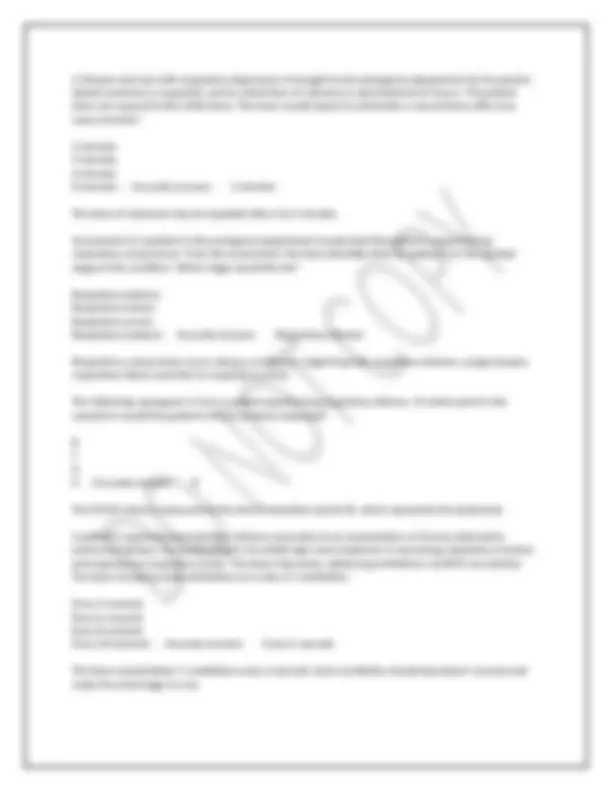


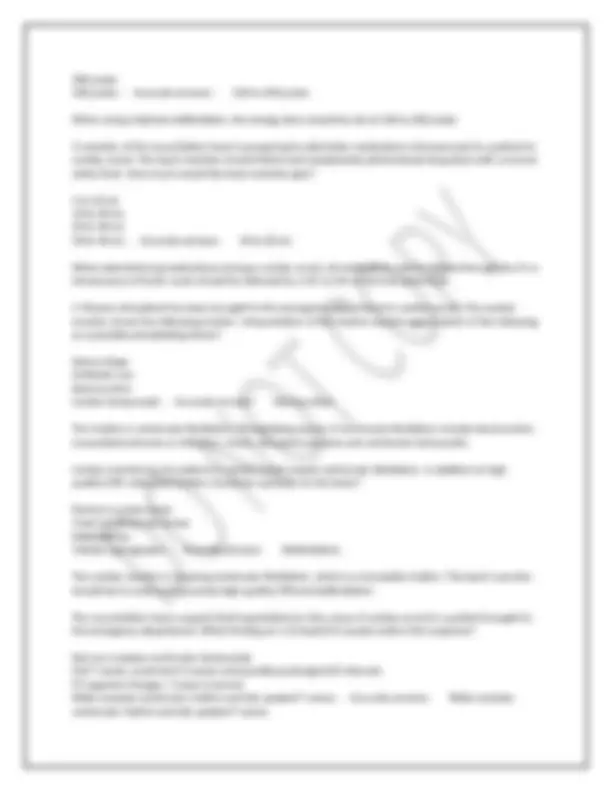
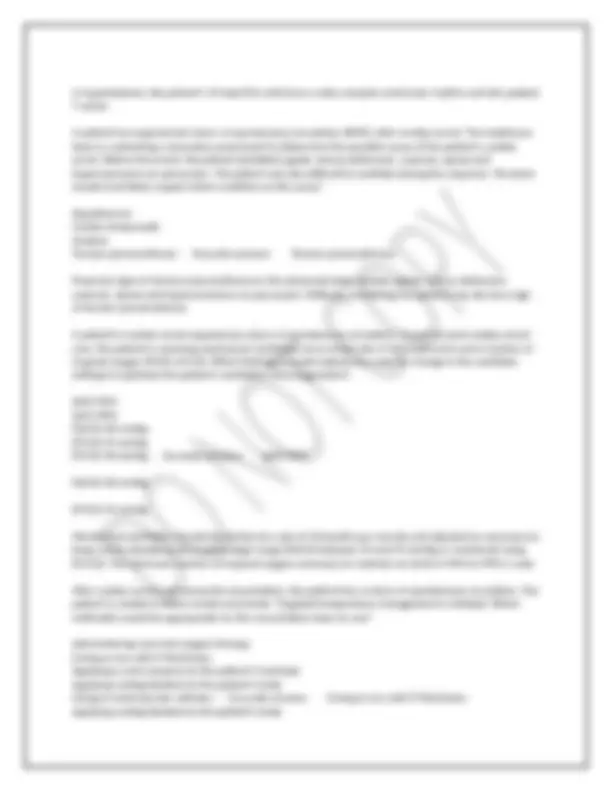
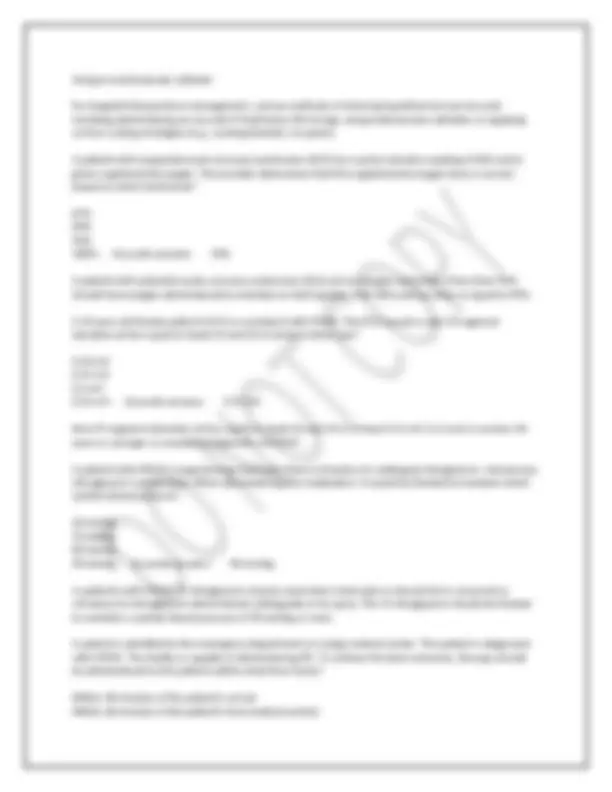
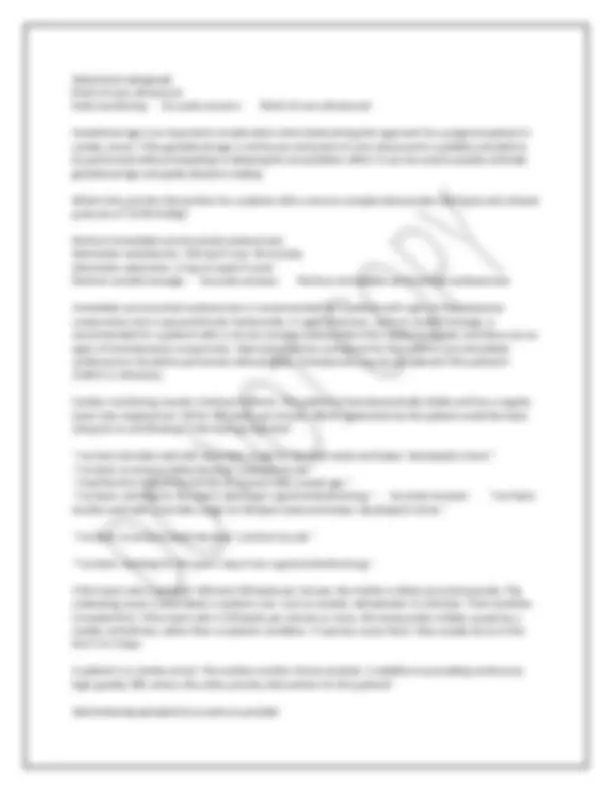




Study with the several resources on Docsity

Earn points by helping other students or get them with a premium plan


Prepare for your exams
Study with the several resources on Docsity

Earn points to download
Earn points by helping other students or get them with a premium plan
Community
Ask the community for help and clear up your study doubts
Discover the best universities in your country according to Docsity users
Free resources
Download our free guides on studying techniques, anxiety management strategies, and thesis advice from Docsity tutors
ACLS FINAL EXAM QUESTIONS WITH 100% ACCURATE ANSWERS
Typology: Exams
1 / 16

This page cannot be seen from the preview
Don't miss anything!










A patient experiences cardiac arrest, and the resuscitation team initiates ventilations using a bag-valve- mask (BVM) resuscitator. The development of which condition during the provision of care would lead the team to suspect that improper BVM technique is being used? Hypertension Esophageal injury Pneumothorax Rib fracture - Accurate answers Pneumothorax Complications can occur with the use of a BVM resuscitator due to improper technique. Delivering excessive volume or ventilating too fast creates excessive pressure that can damage the airways, lungs and other organs. Excessive volume can lead to tension pneumothorax. A person suddenly collapses while sitting in the sunroom of a healthcare facility. A healthcare provider observes the event and hurries over to assess the situation. The healthcare provider performs which assessment first? Rapid assessment Basic life support assessment Secondary assessment Primary assessment - Accurate answers Rapid assessment A systematic approach to assessment is necessary. The healthcare provider should first perform a rapid assessment. A rapid assessment is a visual survey to ensure safety, form an initial impression about the patient's condition (including looking for life-threatening bleeding), and determine the need for additional resources. This would be followed by a primary assessment and then a secondary assessment. A patient is receiving ventilation support via bag-valve-mask (BVM) resuscitator. Capnography is established and a blood gas is obtained to evaluate the adequacy of the ventilations. Which arterial carbon dioxide (PaCO2) value signifies adequate ventilations? 10 to 15 mmHg 20 to 25 mmHg 25 to 30 mmHg 35 to 45 mmHg - Accurate answers 35 to 45 mmHg Arterial carbon dioxide (PaCO2) values in the range of 35 to 45 mmHg confirm adequacy of ventilation. A resuscitation team is debriefing following a recent event. A patient experienced cardiac arrest, and advanced life support was initiated. The patient required the placement of an advanced airway to maintain airway patency. Which statement indicates that the team performed high-quality CPR?
"We initiated chest compressions at a rate of 100 to 110 per minute to a depth of 2.4 inches and then gave 1 ventilation every 10 seconds." "We provided chest compressions at a rate of 100 to 120 compressions per minute while giving 1 ventilation every 6 seconds without pausing compressions." "We provided chest compressions at a rate of 80 to 120 per minute to a depth of at least 2 inches and gave 1 ventilation every 6 seconds without pausing compressions." "We kept the rate of chest compressions to around 100 per minute but adjusted their depth to 1. inches while giving 1 ventilation every 3 seconds without pausing compression - Accurate answers "We provided chest compressions at a rate of 100 to 120 compressions per minute while giving 1 ventilation every 6 seconds without pausing compressions." When an advanced airway has been placed in a patient who is in cardiac arrest, compressions should be delivered continuously (100 to 120 per minute) with no pauses for ventilations. Assessment of a patient reveals an ETCO2 level of 55 mmHg and an arterial oxygen saturation (SaO2) level of 88%. The provider would interpret these findings as indicative of which condition? Respiratory failure Respiratory arrest Cardiac arrest Respiratory distress - Accurate answers Respiratory failure An SaO2 level of less than 90% (PaO2 of less than 50 mmHg) accompanied by ETCO2 values greater than 50 mmHg is indicative of respiratory failure. A responsive patient is choking. What method should the provider use first to clear the obstructed airway? Back blows Abdominal thrusts Magill forceps extraction Chest compressions - Accurate answers Back blows To clear an obstructed airway in a responsive adult, first provide up to 5 back blows to clear the obstruction. A patient arrives at the emergency department complaining of shortness of breath. The patient has a long history of chronic obstructive pulmonary disease. Assessment reveals respiratory failure. Which action would be the initial priority to address the respiratory failure? Establishment of vascular access Delivery of supplemental oxygen via nasal cannula Assisted ventilation with BVM resuscitator Initiation of capnography - Accurate answers Assisted ventilation with BVM resuscitator Patients who cannot ventilate adequately despite an open airway or who have insufficient respiratory effort require assisted ventilation initially provided via a BVM resuscitator.
A patient enters the emergency department in respiratory compromise. The team is monitoring the patient using capnography and identifies that ETCO2 levels are initially 33 mmHg and later 40 mmHg. From these readings, the team identifies that the patient is progressing in what stage of respiratory compromise? Respiratory arrest Respiratory failure Respiratory distress Respiratory acidosis - Accurate answers Respiratory distress Capnography can objectively assess the severity of a patient's respiratory distress. Early on, the patient will often hyperventilate, leading to hypocapnia that is reflected by a low ETCO2 value (less than 35 mmHg). As respiratory distress increases, and the patient begins to tire, the ETCO2 value may return to the normal range (35 to 45 mmHg). However, if the patient progresses to respiratory failure, the ETCO level will increase to greater than 45 mmHg, which indicates hypoventilation. A patient is in cardiac arrest. The underlying cause is thought to be opioid toxicity. Which statement accurately describes the use of naloxone for this patient? Naloxone should be administered immediately as the first action in resuscitation at a dose of 0.4 to 2 mg and then repeated every 2 to 3 min as needed. Naloxone has not been shown to be effective for opioid toxicity once cardiac arrest has occurred. Naloxone administered via continuous IV infusion should be considered for short-acting opioid toxicity. Naloxone should be administered as soon as possible but is not a priority over high-quality CPR and AED use. - Accurate answers Naloxone should be administered as soon as possible but is not a priority over high-quality CPR and AED use. High-quality CPR and AED use are the priority interventions for cardiac arrest caused by suspected or known opioid toxicity. When opioid toxicity is the suspected or known cause of cardiac arrest, naloxone should be administered as soon as possible without disrupting or delaying high-quality CPR and AED use. The recommended dose of naloxone is 0.4 to 2 mg IV/IO/IM/IN/SC, repeated every 2 to 3 minutes as needed. A continuous naloxone infusion may be considered if there is the potential for recurrence of respiratory depression (for example, if the cause of the opioid toxicity was an extended-release or long- acting opioid) but is not indicated in the immediate treatment of suspected or known opioid toxicity A patient in the telemetry unit is receiving continuous cardiac monitoring. The patient has a history of myocardial infarction. The patient's ECG rhythm strip is shown in the following figure. The provider interprets this strip as indicating which arrhythmia? Sinus tachycardia Third-degree AV block First-degree atrioventricular (AV) block Second-degree AV block - Accurate answers Third-degree AV block
In third-degree AV block, no electrical communication occurs between the atria and ventricles, thus no relationship between P waves and QRS complexes exists. The RR interval is constant. The PP interval is constant or slightly irregular, as with sinus arrhythmia. If pacemaker cells in the AV junction simulate ventricular contraction, the QRS complexes will be narrow (less than 120 milliseconds in duration). Impulses that originate in the ventricles produce wide QRS complexes. This arrhythmia may result from damage caused by myocardial infarction. A patient with dyspnea, inadequate blood pressure and a change in mental status arrives at the emergency department. The healthcare team completes the necessary assessments and begins to care for the patient, including initiating cardiac monitoring and pulse oximetry; providing supplemental oxygen and ensuring adequate ventilation; and obtaining vascular access. The team reviews the patient's ECG rhythm strip, as shown in the following figure. Which agent would the team most likely administer? Epinephrine 2 to 10 mcg/min Dopamine 5 to 10 mcg/min Atropine 1 mg every 3 to 5 minutes Amiodarone 150 mg over 10 minutes - Accurate answers Atropine 1 mg every 3 to 5 minutes The ECG strip is showing bradycardia. Atropine is an anticholinergic drug that increases sinoatrial node firing by counteracting vagus nerve action to increase the heart rate. It is the first-line therapy for symptomatic bradycardia. A 1-mg bolus is given intravenously every 3 to 5 minutes, up to a maximum dose of 3 mg. A patient comes to the emergency department complaining of palpitations and "some shortness of breath." Cardiac monitoring is initiated and reveals the following ECG rhythm strip. The provider interprets this strip as indicating which arrhythmia? Atrial fibrillation Atrial flutter Ventricular fibrillation Ventricular tachycardia - Accurate answers Atrial flutter In atrial flutter, atrial contraction occurs at such a rapid rate that discrete P waves separated by a flat baseline cannot be seen on the strip. Instead, the baseline continually rises and falls, producing the "flutter" waves. In leads II and III, the flutter waves may be quite prominent, creating a "sawtooth" pattern. Because of the volume of atrial impulses, the AV node allows only some of the impulses to pass through to the ventricles. In atrial flutter, a 2:1 ratio is the most common (i.e., for every two flutter waves, only one impulse passes through the AV node to generate a QRS complex). Ratios of 3:1 and 4: are also frequently seen. The ECG rhythm strip of a patient who arrived in the emergency department complaining of dizziness, syncope and shortness of breath reveals sinus bradycardia. When reviewing the patient's medication history, the healthcare provider identifies which agent(s) as a potential cause of the patient's current condition? Digoxin
Absence of discrete P waves and presence of irregularly irregular QRS complexes Narrow QRS complex with PP interval constant or slightly irregular - Accurate answers Absence of discrete P waves and presence of irregularly irregular QRS complexes The two key features of atrial fibrillation on ECG are the absence of discrete P waves and the presence of irregularly irregular QRS complexes. Cardiac monitoring indicates that a patient has a ventricular tachyarrhythmia. The patient has a pulse and is not showing any signs of hemodynamic compromise. A 12-lead ECG reveals an irregular rhythm with QRS complexes greater than 0.12 second in duration. Which action would be appropriate at this time? Defibrillation Synchronized cardioversion Atropine Consider an antiarrhythmic medication - Accurate answers Consider an antiarrhythmic medication For a patient with a wide-complex tachyarrhythmia and no signs of hemodynamic compromise, consider an antiarrhythmic medication (procainamide, amiodarone or sotalol). A patient is brought into the emergency department. The patient does not have a pulse. The cardiac monitor shows the following rhythm. The team interprets this as which condition? Ventricular tachycardia Torsade de pointes Asystole Ventricular fibrillation - Accurate answers Ventricular tachycardia The cardiac monitor reveals ventricular tachycardia. In pulseless ventricular tachycardia, the ventricular rate is usually greater than 180 beats per minute, and the QRS complexes are very wide. A patient with acute renal failure experiences cardiac arrest. Just before the cardiac arrest, the patient's ECG showed peaked T waves. What might be causing the patient's cardiac arrest? Hypoxia Hypothermia Hyperkalemia Acidosis - Accurate answers Hyperkalemia Suspect hyperkalemia in all patients with acute or chronic renal failure who exhibit a wide-complex ventricular rhythm or tall, peaked T waves on an ECG before cardiac arrest. A member of the resuscitation team is preparing to defibrillate a patient in cardiac arrest using a biphasic defibrillator. The team member would set the energy dose according to the manufacturer's recommendations, which is usually: 75 to 100 joules 120 to 200 joules
300 joules 360 joules - Accurate answers 120 to 200 joules When using a biphasic defibrillator, the energy dose should be set at 120 to 200 joules. A member of the resuscitation team is preparing to administer medications intravenously to a patient in cardiac arrest. The team member should follow each peripherally administered drug dose with a normal saline flush. How much would the team member give? 5 to 10 mL 10 to 20 mL 20 to 30 mL 30 to 40 mL - Accurate answers 10 to 20 mL When administering medications during a cardiac arrest, all medications administrated through the IV or intraosseous infusion route should be followed by a 10- to 20-mL normal saline flush. A 30-year-old patient has been brought to the emergency department in cardiac arrest. The cardiac monitor shows the following rhythm. Interpretation of this rhythm would suggest which of the following as a possible precipitating factor? Hemorrhage Antibiotic use Electrocution Cardiac tamponade - Accurate answers Electrocution The rhythm is ventricular fibrillation. Precipitating causes of ventricular fibrillation include electrocution, myocardial ischemia or infarction, shock, stimulant overdose and ventricular tachycardia. Cardiac monitoring of a patient in cardiac arrest reveals ventricular fibrillation. In addition to high- quality CPR, what intervention should be a priority for the team? Perform a pulse check. Insert an advanced airway. Defibrillation. Initiate capnography. - Accurate answers Defibrillation. The cardiac monitor is showing ventricular fibrillation, which is a shockable rhythm. The team's priority should be to continue to provide high-quality CPR and defibrillation. The resuscitation team suspects that hyperkalemia is the cause of cardiac arrest in a patient brought to the emergency department. Which finding on a 12-lead ECG would confirm this suspicion? Narrow-complex ventricular tachycardia Flat T waves, prominent U waves and possibly prolonged QT intervals ST-segment changes, T-wave inversion Wide-complex ventricular rhythm and tall, peaked T waves - Accurate answers Wide-complex ventricular rhythm and tall, peaked T waves
Using an endovascular catheter For targeted temperature management, various methods of inducing hypothermia may be used, including administering an ice-cold IV fluid bolus (30 mL/kg), using endovascular catheters or applying surface cooling strategies (e.g., cooling blankets, ice packs). A patient with suspected acute coronary syndromes (ACS) has a pulse oximetry reading of 86% and is given supplemental oxygen. The provider determines that the supplemental oxygen dose is correct based on which SaO2 level? 87% 89% 93% 100% - Accurate answers 93% A patient with potential acute coronary syndromes (ACS) and an oxygen saturation of less than 90% should have oxygen administered to maintain an SaO2 greater than 90% and less than or equal to 99%. A 35-year-old female patient's ECG is consistent with STEMI. The ECG reveals a new ST-segment elevation at the J point in leads V2 and V3 of at least which size? 0.10 mV 0.15 mV 0.2 mV 0.25 mV - Accurate answers 0.15 mV New ST-segment elevation at the J point in leads V2 and V3 of at least 0.15 mV (1.5 mm) in women 40 years or younger is considered diagnostic of STEMI. A patient with STEMI is experiencing chest pain that is refractory to sublingual nitroglycerin. Intravenous nitroglycerin is prescribed. When administering this medication, it would be titrated to maintain which systolic blood pressure? 60 mmHg 70 mmHg 80 mmHg 90 mmHg - Accurate answers 90 mmHg In patients with STEMI, IV nitroglycerin may be used when chest pain or discomfort is recurrent or refractory to nitroglycerin administered sublingually or by spray. The IV nitroglycerin should be titrated to maintain a systolic blood pressure of 90 mmHg or more. A patient is admitted to the emergency department of a large medical center. The patient is diagnosed with STEMI. The facility is capable of administering PCI. To achieve the best outcomes, therapy should be administered to this patient within what time frame? Within 30 minutes of the patient's arrival Within 60 minutes of the patient's first medical contact
Within 90 minutes of the patient's first medical contact Within 3 hours of the onset of symptoms - Accurate answers Within 90 minutes of the patient's first medical contact Reperfusion should be administered within 90 minutes of the patient's first medical contact if the patient does not need to be transferred to another facility. A patient is being treated in the emergency department and is determined to have NSTE-ACS. Invasive management is planned based on which finding? Atrial tachycardia Ventricular tachycardia Atrial fibrillation Hypoxia - Accurate answers Ventricular tachycardia An early invasive strategy should be considered for patients with high-risk NSTE-ACS, which would be indicated by ventricular tachycardia. A patient is admitted to the emergency department with signs and symptoms of stroke. The stroke team should complete a comprehensive neurologic assessment and obtain brain imaging results within what time frame? Within 10 minutes Within 20 minutes Within 30 minutes Within 40 minutes - Accurate answers Within 20 minutes The stroke team should complete a comprehensive neurologic assessment and obtain brain imaging results within 20 minutes. Which areas are evaluated using the National Institutes of Health Stroke Scale (NIHSS)? Facial palsy Hearing Language deficits Visual function Level of consciousness - Accurate answers Facial palsy Language deficits Visual function Level of consciousness The National Institutes of Health Stroke Scale (NIHSS) evaluates level of consciousness, best gaze, visual fields, facial palsy, motor function (arm and leg), limb ataxia, sensation, language deficits and extinction and inattention. The stroke team is assessing a patient with a suspected stroke. The patient is alert and able to carry on a conversation, although the patient has difficulty getting the words out. Testing confirms that the patient
Abdominal radiograph Point-of-care ultrasound Fetal monitoring - Accurate answers Point-of-care ultrasound Gestational age is an important consideration when determining the approach to a pregnant patient in cardiac arrest. If the gestational age is not known and point-of-care ultrasound is available and able to be performed without impeding or delaying the resuscitation effort, it can be used to quickly estimate gestational age and guide decision-making. What is the priority intervention for a patient with a narrow-complex tachycardia (160 bpm) and a blood pressure of 72/48 mmHg? Perform immediate synchronized cardioversion Administer amiodarone, 150 mg IV over 10 minutes Administer adenosine, 6 mg via rapid IV push Perform carotid massage - Accurate answers Perform immediate synchronized cardioversion Immediate synchronized cardioversion is recommended for a patient with signs of hemodynamic compromise and a supraventricular tachycardia. A vagal maneuver, such as carotid massage, is recommended for a patient with a narrow-complex tachycardia if the rhythm is regular and there are no signs of hemodynamic compromise. Adenosine may be considered for this patient, but immediate cardioversion should be performed without delay. Amiodarone may be considered if this patient's rhythm is refractory. Cardiac monitoring reveals a tachyarrhythmia. The patient is hemodynamically stable and has a regular heart rate ranging from 120 to 135 beats per minute. Which statements by the patient could the team interpret as contributing to the tachyarrhythmia? "I've had a terrible cold with a horrible cough for the past week and today I developed a fever." "I've been so anxious lately because I just lost my job." "I had the first shot of the COVID-19 vaccine over a week ago." "I've been vomiting for the past 2 days from a gastrointestinal bug." - Accurate answers "I've had a terrible cold with a horrible cough for the past week and today I developed a fever." "I've been so anxious lately because I just lost my job." "I've been vomiting for the past 2 days from a gastrointestinal bug." If the heart rate is between 100 and 150 beats per minute, the rhythm is likely sinus tachycardia. The underlying cause is most likely a systemic one, such as anxiety, dehydration or infection. That condition is treated first. If the heart rate is 150 beats per minute or more, the tachycardia is likely caused by a cardiac arrhythmia, rather than a systemic condition. If vaccines cause fever, they usually do so in the first 1 to 3 days. A patient is in cardiac arrest. The cardiac monitor shows asystole. In addition to providing continuous high-quality CPR, what is the other priority intervention for this patient? Administering epinephrine as early as possible
Inserting an advanced airway Defibrillating with 360 joules when available Administering amiodarone as early as possible - Accurate answers Administering epinephrine as early as possible For cardiac arrest with a nonshockable rhythm, epinephrine (1 mg IV/IO) should be administered as early as possible and repeated every 3 to 5 minutes. Although inserting an advanced airway may be considered for this patient, this is not a priority intervention. Defibrillation and amiodarone are not appropriate interventions for asystole. A 42-year-old woman presents to the emergency department with complaints of fatigue, shortness of breath, back pain and nausea. A 12-lead ECG is obtained and shows ST-segment depression in leads II, III, and aVF and intermittent runs of nonsustained ventricular tachycardia. Cardiac serum markers are elevated. These findings suggest which condition? High-risk non-ST-segment elevation ACS (NSTE-ACS) Low-risk non-ST-segment elevation ACS (NSTE-ACS) Intermittent-risk non-ST-segment elevation ACS (NSTE-ACS) ST-segment elevation myocardial infarction (STEMI) - Accurate answers High-risk non-ST-segment elevation ACS (NSTE-ACS) The 12-lead ECG findings of ST-segment depression in three contiguous leads along with elevated cardiac serum biomarkers are consistent with high-risk non-ST-segment elevation ACS (NSTE-ACS). The presence of intermittent runs of ventricular tachycardia also places this patient at high risk. In ST- segment elevation myocardial infarction (STEMI), cardiac serum markers would be elevated, but this patient's ECG findings are not consistent with STEMI. Patients with intermediate- or low-risk NSTE-ACS show nondiagnostic ST-segment or T-wave changes on ECG, or no changes at all. Which statements accurately reflect the recommendations for post-cardiac arrest patient care? Prophylactic anticonvulsants should be administered to patients who remain comatose after cardiac arrest to prevent seizures. Arterial blood gases may be used to guide ventilation and oxygenation in the post-cardiac arrest patient. Targeted temperature management (TTM) should not be initiated in a post-cardiac arrest patient who is receiving mechanical circulatory support. Perfusion should be assessed and maintained to ensure the best outcome for the post-cardiac arrest patient. - Accurate answers Arterial blood gases may be used to guide ventilation and oxygenation in the post-cardiac arrest patient. Perfusion should be assessed and maintained to ensure the best outcome for the post-cardiac arrest patient. Priorities for the post-cardiac arrest patient include managing hemodynamics to ensure and maintain adequate perfusion and optimizing ventilation and oxygenation. Arterial blood gases may be used to ensure ventilation and oxygenation levels are in the physiologic range. Prophylactic anticonvulsant therapy has not been shown to be of benefit for preventing seizures or for improving other clinical outcomes and is not recommended in the care of the post-cardiac arrest patient. Mechanical circulatory support can be initiated concurrently with targeted temperature management (TTM).
Decision-making related to the continuation or withdrawal of life-sustaining treatments should be delayed until 72 hours after return of spontaneous circulation (ROSC) and following return to normothermia.